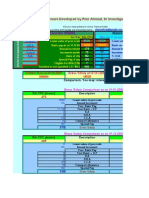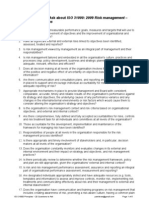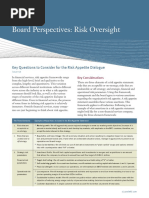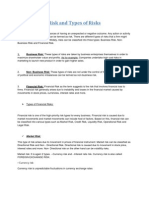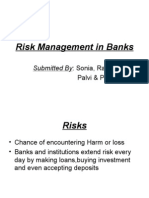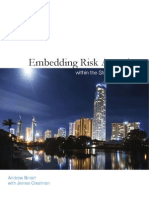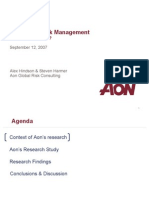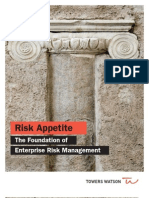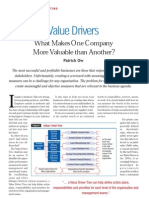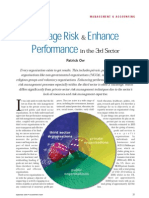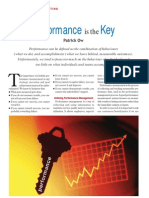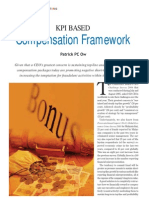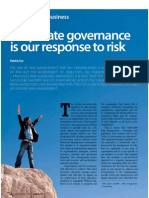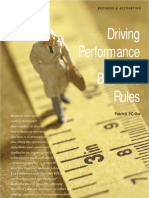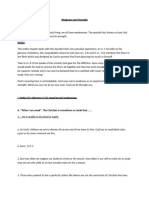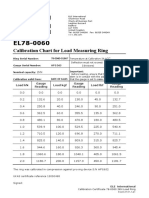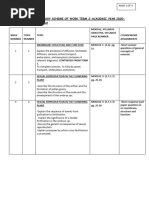Embedding Risk Management For Improved Organisational Performance
Embedding Risk Management For Improved Organisational Performance
Uploaded by
Patrick OwCopyright:
Available Formats
Embedding Risk Management For Improved Organisational Performance
Embedding Risk Management For Improved Organisational Performance
Uploaded by
Patrick OwOriginal Title
Copyright
Available Formats
Share this document
Did you find this document useful?
Is this content inappropriate?
Copyright:
Available Formats
Embedding Risk Management For Improved Organisational Performance
Embedding Risk Management For Improved Organisational Performance
Uploaded by
Patrick OwCopyright:
Available Formats
MANAGEMENT & ACCOUNTING
Embedding Risk Management Practices for
Improved Organisational Performance
Patrick Ow
Improving business results require risk management practices to be simplified and embedded
seamlessly into normal business operations, planning and budgeting processes, and
organisational culture. It is no longer an add-on or a management fad. Private and public sector
organisations alike have struggled to understand risk management implementation steps and
techniques. For those who have overcome it, they are reaping the fruits of their labour.
H
igh performing organisations, Risk is the likelihood of something hap- signed to provide reasonable assurance that
having developed strategies pening (either positive or negative) that operations are effective and efficient,
through a sound strategic plan- will have a consequence or impact (aris- organisational reporting is complete, reliable,
ning process, must ruthlessly implement ing from the event) upon the achievement accurate and timely, and that all applicable laws
strategies by removing performance bar- of objectives. Risk management standard and regulations are complied with.
riers or risk through enterprise-wide risk AS/NZ 4360:2004 defines risk as “the Effective risk management calls for a col-
management practices. chance of something happening that will laborative approach involving all parts of the
Organisations can implement their strat- have an impact on objectives”. organisation. Taking an enterprise-wide
egy and perform well if: approach to risk management is vital as risk
Risk = Likelihood X Consequence
䡲 Everyone understands strategic, unit and in different units may be within the risk
departmental objectives, measures and Like the risk management process itself, an appetite of that individual unit. Taken to-
targets and key priorities (clarity). enterprise-wide approach (or commonly gether, that unit’s risk might exceed the risk
䡲 Everyone is connected emotionally and known as enterprise risk management, ERM) appetite of the organisation as a whole - in
engaged to strategic themes, key objec- to manage risks arose from the business sec- which case, different risks responses may
tives and organisational priorities (com- tor and it is being adopted by public and not- be required to bring the individual unit’s
mitment). for-profit organisations around the world. risk in line with the organisation’s risk ap-
䡲 There is clear “line-of-sight” for each in- The Committee of Sponsoring Organ- petite.
dividual, department, and unit so that they isations of the Treadway Commission The starting point is the organisation’s
are closely aligned to the organisation’s (COSO) has broadly defined ERM as “a objectives, encapsulated by their vision and
key priorities (translation). process, affected by an entity’s board of di- strategy.
rectors, management and other personnel, From objectives, SMART (specific, mea-
䡲 Structure, system and cultural barriers
applied in strategy setting and across the surable, achievable, realistic, and timed)
are removed through embedded enter-
enterprise, designed to identify potential performance measures and quantifiable
prise-wide risk management process (en-
events that may affect the entity, and man- targets are developed. Measures and tar-
abling).
age risk to be within its risk appetite, to gets are important as what gets measured
䡲 Everyone works together to arrive at bet-
provide reasonable assurance regarding gets managed and done.
ter ways to achieve objectives and tar-
the achievement of entity objectives.” From the highest level, guided by
gets, removing “its not my job” thinking
The enterprise-wide approach to risk man- organisational structure, organisational vi-
(synergy).
agement does not necessarily negate or replace sion and strategies are cascaded down and
䡲 Individuals are responsible for achieving the traditional risk management process and forms the strategic objectives, and perfor-
targets (accountability). mitigating risk controls, which is summarised mance measures and targets, which in turn
䡲 Everyone is a de facto risk manager (re- in Table 1. Controls are policies, procedures, cascades down, is weighted and forms
sponsibility). practices and organisational structures de- each business and supporting units’ objec-
26 ACCOUNTANTS TODAY • April 2008
Embedding Risk Management Practices for Improved Organisational Performance
tives, and performance measures and tar-
Diagram 1 Mapping the Cascading Process to Organisational Structure
gets. Then it cascades down further as de-
partmental and project objectives where Organisation
applicable. Ultimately, all objectives must Vision/
be cascaded into everyone’s individual per- Board Strategy
Strategic
formance objectives, as measured by their Objectives/
Measures/
annual performance plan. (See Diagram 1) CEO Targets
Prioritise objectives throughout each level
of the organisation. For prioritisation, de- Business
velop strategic themes (or value drivers) that Objectives/
n Performance to Strategy
Business Units Measures/
align to the organisational vision and strat- Targets
egy. Examples of strategic themes include
revenue growth, sustainable outcomes and Functional
Objectives/
efficiency. Eliminate organisational activities Support Units Measures/
Targets
or initiatives that do not support strategy
& Aligning
implementation. The prioritisation process
Operational
ensures clear focus or line-of-sight perfor- Objectives/
Departments
mance for everyone within the organisation. Measures/
Cascading
Targets
Use management tools like the balanced
s
scorecard to cascade down top-level objec- Project
tives, and performance measures and tar- Objectives/
Projects Measures/
gets systematically throughout the Targets
organisation, right down to each individual,
which is based on four perspectives (finan- Individual
Staff Objectives/
cial, customer, processes, and people)1. Measures/
Targets
1 “Beyond Measurement Alone — Optimising Two-way influences
Corporate Performance”, Accountants Today,
November 2005, page 48.
Table 1 Risk & Control Cycle
Risk/Control Cycle Description Key Questions
Set/Confirm Objectives Clarify what the organisation seeks to achieve, • What are we trying to achieve?
starting with its vision and strategic objectives.
Identify Events/Risk to Achieving those Identify all events and risks that may affect/ im- • What could go wrong?
Objectives pact the achievement of these objectives. • What could happen that would affect our ob-
jectives?
Assess Risks Assess likelihood that each risk will materialise • What is the likelihood or probability that the
and calculate the consequences arising from the risk will occur?
risk. • What is its consequence or impact if the risk
does eventuate?
Identify Risk Responses Identify and select cost-effective responses to • What are the risk responses or options avail-
managing risk, based on a Board – approved risk able to us to address risk?
appetite.
Execute Control Activities To Address Risk Implement cost-effective risk control activities • How do we rate the control effectiveness?
to address or mitigate risks, as encapsulated in • In the light of risk control assessment and
a risk management plan. prioritisation, what is the most cost-effec-
tive way to address/mitigate the risk?
Develop Effective Information and Develop cost-effective information and commu- • How can we integrate risk as well as per-
Communication nication systems and processes to enable the formance information and indicators into
organisation in meeting its objectives, and for our everyday business performance report-
timely reporting of risks and decision-making. ing and decision-making processes?
Implement On-going Monitoring Activities to Once risk controls are established, develop and • How do we use information management
Ensure Controls are Effective implement on-going cost effective monitoring systems and technologies/IT to maintain or
activities to ensure that risk management and enhance our on-going risk monitoring and
control practices continue to operate effectively performance reporting capability?
and ef ficiently as an integral par t of
organisational culture and business processes.
April 2008 • ACCOUNTANTS TODAY 27
Embedding Risk Management Practices for Improved Organisational Performance
(See Diagram 2)
Diagram 2 Cascading Corporate Measures using the Balanced Scorecard Approach
Map and allocate each strategic objec-
Corporate tive into business and support units’ objec-
Process Financial 20% (Operating Margin) tives as shown in Diagram 3. Not all stra-
Customer 25% (Customer Satisfaction)
tegic objectives are applicable to all units.
Customer People Processes 35% (Safety Index)
People 20% (Employee Satisfaction) ‘Weight’ the achievement of each unit for
BU 1 BU 2 clarity so that individuals managing their
Process Process Financial 20% (Operating Expenses)
own unit are clear about their unit perfor-
Customer 25% (Customer Retention)
Customer People Customer People Processes 35% (Days Absent) mance, avoiding any finger pointing. Elimi-
People 20% (Certification) nate joint responsibilities.
Dept A Dept B
Thereafter, develop risk management
Process Process Financial 10% (Variable Cost)
Customer 35% (First Pass Yield) plans for each level of objectives (whether
Customer People Customer People Processes 30% (Accidents) strategic, business, functional, operational
People 25% (Cross-Training)
and project) as an integral par t of
Individual 1 Individual 2
Customer 35% (On -time Delivery)
organisational culture, planning and bud-
Process Process
Processes 35% (Log Book Violations) geting processes, and performance man-
Customer People Customer People People 30% (Achieving Targets) agement practices. (Shown in Diagram 4)
All risk management plans interact with
each other constantly, “passing” risk items
Diagram 3 Cascading and Aligning Corporate Measures Enterprise-Wide up and down through dif ferent
Organisation Business Unit 1 Business Unit 2 Business Unit 3 Support Unit 1 Support Unit 2 organisational levels based on its imple-
(Sales) (Customer Service) (Production) (Finance) (Human Resource) mentation capability over the risk items.
Strategic Objective 1 $7.0 mil $3.0 mil Criteria for passing risk are categorisation,
(Revenue/ Funding (70%) (30%)
RM10mil) materiality and/or impact upon the
Strategic Objective 2 30% of responses 70% of responses organisation — similar to perhaps the cri-
above 98% above 98%
(Customer
satisfaction satisfaction teria for passing information to the Board.
Satisfaction 98%)
For example, if a unit cannot address risk
Strategic Objective 3 Safety above 95% solely by itself because they do not have
(Safety Index 95%) benchmark
control, influence and/or authority over
Strategic Objective 4
Ave 85% of all staff Ave 85% of all staff Ave 85% of all staff Ave 85% of all staff Ave 85% of all staff the implementation of the risk control, that
employed within Unit employed within Unit employed within Unit employed within Unit employed within Unit
(Employee unit’s risk must be passed up as a risk item
Satisfaction 85%)
into the organisational risk profile for cor-
porate action.
Cascading & Aligning Performance to Strategy Alternatively, if the risk control were op-
erational in nature within that unit, the Unit
Diagram 4 Developing and Integrating Individual Risk Management Plans Enterprise-Wide Head would pass down that risk item into
the department’s risk management plan for
Organisation Business Unit 1 Business Unit 2 Business Unit 3 Support Unit 1 Support Unit 2
(Sales) (Customer Service) (Production) (Finance) (Human Resource) the Department Head’s attention. The De-
Strategicc Ob
Objective 1 $7.0
7.0 m
mil $3.0
3.0 m
mil partment Head would then be responsible
(Revenue/e/ FFunding (70%)
70% (30%)
30% for that risk. This interaction process en-
RM10mil)
sures that someone will act upon risk iden-
Strategicc Ob
Objective 2 30% off res
responses 70% off res
responses tified from any part of the organisation.
(Customeer aboveve 998% above
ove 998%
Satisfaction
tion 98%) satisfaction
sfac satisfaction
sfac
Integrate the risk management process
into the strategic management process if
Strategicc Ob
Objective 3 Safety abov
above 95% organisational culture and processes per-
(Safety Index
ndex 95%) benchmark
chm
mits as shown in Diagram 5.
Strategicc Ob
Objective 4 Ave 85%
% of all staff Ave 85%
% of all staff Ave 85%
% of all staff Ave 85%
% of all staff
For example, accompany business propos-
(Employeee employedd wi
within Unit employedd w
within Unit employed
ed w
within Unit employedd wi
within Unit als with a sub-section on risk management.
Satisfaction
tion 85%)
The risk management sub-section clearly
Org Business Business Business Functional Functional sets out all key risks affecting the achieve-
Risk Risk Risk Risk Risk Risk ment of the business proposal, clearly iden-
Profile Mgt Plan Mgt Plan Mgt Plan Mgt Plan Mgt Plan
tifying responsibility and accountability for
risk control, what funding is allocated from
existing (or future) budgets to address these
Cascading & Aligning Performance to Strategy
risks and whether the business proposal
28 ACCOUNTANTS TODAY • April 2008
Embedding Risk Management Practices for Improved Organisational Performance
clearly promotes the achievement of
Diagram 5 Integrating Risk Management into Strategic Planning Process2
organisational strategy through clear mea-
surable output and/ or outcomes.
As part of a manager’s monthly perfor- Establish Context & Determine & Assess & Evaluate Determine Risk Identify Cost
Identify Evaluate Existing (Quantify) Risk Appetite & Agree on Effective Risk
mance report, include a section on risk Performance
Related Risk
Controls Likelihood & Impact Acceptable Risk
Levels/ Tolerance
Actions/ Treatments
(Risk Mgt Plan)
management, identifying issues or risk
Monitor Control & Execution Gap
potentially affecting the manager’s perfor-
Identify Objectives/ Monitor Update
mance for their unit or department. This Drivers &
Identify Actions
Required (Strategy Implementation of
Monitor/ Review
Changes (External/ Assumptions,
Environment Formulation) Actions (Strategy Internal) Plans, Controls &
way, risk management is not about box Scanning Implementation) Objectives
ticking but becomes an integral part of per-
formance reporting and management.
Risk Management Process
Therefore, risk management must NOT
be an add-on or separated as an indepen- 2 “Outperform by Linking Performance and Risk Management”, Accountants Today, February 2008, page 26.
Diagram 6 Embedding Risk Management Plans Enterprise-Wide
Organisation Enterprise-Wide
Vision/ Risk Strategy &
Strategy Appetite
Strategic Organisational
Objectives/
Measures/ Risk Profile
Targets
Integral Part of Business Planning, Budgeting; Performance Management
Business
Objectives/ Business Risk
n Performance to Strategy
Measures/ Mgt Plan
Targets
Risk to Risk Strategy
a
Functional
Objectives/ Functional Risk
Measures/ Mgt Plan
Targets
& Aligning
& Aligning EEnterprise-Wide R
Operational
Objectives/ Operational Risk
Measures/ Mgt Plan
Cascading
Targets
s
Project
Objectives/ Project Risk
Measures/
Mgt Plan
Targets
Cascading
a
Individual
Objectives/ Performance
Measures/ Plan
Two-way influences Targets
dent activity. Risk management must be part sum of its parts. ment with assurance that a responsible
of organisational culture, embedded as part 2 Supporting units’ objectives must sup- person is continuously monitoring or
of everyday organisational life as shown in port the achievement of business units’ implementing risk controls.
Diagram 6. The risk management plan is objectives. 5 Rename your Risk and Audit Depart-
therefore a “living document” embedded as 3 Adequately resource risk controls activi- ment to Business Assurance Department.
a sub-set of performance reporting and bud- ties from budgets but prioritise against 6 Avoid “risk manager” job titles since
get reviews, where risk and achievements strategic themes. Otherwise, risk man- risk ownership is a collective matter.
are constantly monitored and evaluated agement plans become meaningless. Using one of the many approaches
against strategy and objectives. 4 Monitor and report on risk activities shown in Table 2, inputs, activities, outputs,
Take note of the following: through performance reports, rather and outcomes are chain of events that de-
1 Avoid silo-based risk management than specific risk reports. Integrate risk scribe organisational, unit and departmen-
practices as changes to one part of any reporting into performance or monthly tal performance. Inputs (e.g. qualified train-
system or organisation will affect other reports as it aids the achievement of ers recruited) lead to activities (e.g. train-
parts since the whole can exceed the business results, providing manage- ing activities), which lead short-term out-
April 2008 • ACCOUNTANTS TODAY 29
Embedding Risk Management Practices for Improved Organisational Performance
puts (e.g. number of training sessions con- the long-term outcomes (e.g. improvement “Are we doing things right?”, whereas out-
ducted). At some point, the customer or in staff competencies and behaviours as puts and outcomes answer the question “Are
beneficiaries served by organisational ac- the long-term result of the training). we doing the right things?”. By measuring/
tivities will either achieve or not achieve Inputs and activities answer the question quantifying the chain of events, we are able
to determine the performance barriers or
Table 2 Risk & Control Cycle risk, which would feed into risk manage-
Item Description Sample Performance Indicators/ ment plans. Knowing the measures help
Measures in the risk identification process.
Objectives • Goal, planned or intended • Improve quality of learning Subsequently, risk management plans (Dia-
outcome. and student performance. gram 7) can be developed from the inputs,
Inputs • Resources consumed by the system, • Government Funds — activities, outputs, and outcomes chain of
including cost/workforce. $30.0 mil.
events. The risk management plan sets out
• Financial/staffing. • 100 qualified trainers.
cost-effective risk controls required to achieve
Activities • Steps to produce the output. • 2,000 training hours.
objectives, evaluation of risk likelihood and
• Quality, quantity, timeliness, efficiency. • 1,000 workshop hours.
consequences, and determine inherent risks
Outputs • Products & services produced. • 20,000 trained teachers.
• Productivity (units of work).
the organisation is prepared to accept in line
• 4.3 million new textbooks.
• 90% trainer satisfaction. with the Board-approved risk appetite as en-
Outcomes • Results that accomplish the mission; • 20% increase in student capsulated it its Enterprise-wide Risk Strategy.
impacts. test scores. The organisation can either be a risk-averse
• Behaviour changes. • 10% increase in future earnings or risk-taking organisation. By shifting the risk
• Programme/service effectiveness. of primary school graduates. control fulcrum as shown in Diagram 8,
Risk and • Assumptions are risk and enabling • Inadequate provision of organisations can strategically position and set
Critical factors. They are external conditions Government funding. their risk tone for managing risk. However,
Assumptions that are outside the direct control • Selected trainer is competent.
there is always a cost to implementing risk
of the organisation. • Students have the ability to
• Achieving objectives can depend on concentrate. controls. Weak currency may for example
whether assumptions hold true. become an inherent risk that the organisation
• Assumptions are made about the has to accept, with little it could do directly.
degree of uncertainty (degree of risk) In summary, performance is all about
between different levels of objectives.
achieving the corporate objectives and execut-
Diagram 7 Sample Risk Management Plan
Risk Controls
Risk Consequencee Likelihood Risk Resources
Risk Event Impact Mitigation Effectiveness Responsibilityy Timing
g
No Rating Rating Rating
ing Required
Strategy Rating
What can
happen
Describe
How it can happen controls that
mitigates the
risk
Likelihoodd of
What consequence Date when Funding/
identified risk
might be if risk risk action resourcing the
occuring
occurs Evaluate adequacy is due implementation
of risk controls of risk strategy
Rating = Consequence X Likelihood
Mapped against Risk Profile Individual responsible for
managing risk action plan,
and making sure all actions
are completed
ing organisational strategy. Performance bar-
Diagram 8 Strategically Positioning Organisational Risk Appetite
riers or risks must be identified and mitigated
as part of managing organisational perfor-
mance. Enterprise-wide risk management
practices must therefore be an integral man-
agement tool that forms part of any corporate
performance management system. AT
The writer can be contacted at patrickow@
gmail.com
30 ACCOUNTANTS TODAY • April 2008
You might also like
- 6th Central Pay Commission Salary CalculatorDocument15 pages6th Central Pay Commission Salary Calculatorrakhonde100% (436)
- Assignment UED E PORTFOLIODocument25 pagesAssignment UED E PORTFOLIONur Aisyah100% (3)
- New Age Enterprise Risk ManagementDocument8 pagesNew Age Enterprise Risk Managementtitagarhsushovan100% (2)
- ERM CharterDocument3 pagesERM ChartertitooluwaNo ratings yet
- ERM Risk CatalogDocument15 pagesERM Risk CatalogMary Nicks100% (1)
- ERM PresentationDocument12 pagesERM PresentationSamhitha KandlakuntaNo ratings yet
- Operational Risk Management Plan A Complete Guide - 2020 EditionFrom EverandOperational Risk Management Plan A Complete Guide - 2020 EditionNo ratings yet
- Practice Aid: Enterprise Risk Management: Guidance For Practical Implementation and Assessment, 2018From EverandPractice Aid: Enterprise Risk Management: Guidance For Practical Implementation and Assessment, 2018No ratings yet
- ISO 31000 - 20 Key Questions To AskDocument5 pagesISO 31000 - 20 Key Questions To AskPatrick OwNo ratings yet
- Tanker Ships Safety Systems PDFDocument59 pagesTanker Ships Safety Systems PDFRafael100% (1)
- Chartered Risk Governance and Compliance OfficerFrom EverandChartered Risk Governance and Compliance OfficerRating: 5 out of 5 stars5/5 (1)
- Strategic RiskDocument18 pagesStrategic RiskJonisha JonesNo ratings yet
- Basel II Operational RiskDocument5 pagesBasel II Operational RiskLyn SpoonerNo ratings yet
- Capital, Liquidity, Recovery and Resolution Plans: Helping You Manage Your SREP FrameworkDocument8 pagesCapital, Liquidity, Recovery and Resolution Plans: Helping You Manage Your SREP FrameworkmohamedNo ratings yet
- A. N - Bhagat - Risk Officer C.M.Chugh, AGM (Civil) - Resource Person Anand Trivedi, MGR (U&S) - Resource PersonDocument67 pagesA. N - Bhagat - Risk Officer C.M.Chugh, AGM (Civil) - Resource Person Anand Trivedi, MGR (U&S) - Resource PersonAnil100% (2)
- Strategic Risk Management: A.V. VedpuriswarDocument47 pagesStrategic Risk Management: A.V. Vedpuriswarthemmel100% (1)
- Risk Assessment Worksheet and Template 2Document7 pagesRisk Assessment Worksheet and Template 2aviewatsNo ratings yet
- 8 - Tatakelola Risiko - 1Document100 pages8 - Tatakelola Risiko - 1Haggai Pesakh PercivalNo ratings yet
- Ey Shifting Focus Risk Culture at The Forefront of BankingDocument86 pagesEy Shifting Focus Risk Culture at The Forefront of BankingChristian AquinoNo ratings yet
- Risk Management Standards1880Document34 pagesRisk Management Standards1880Direct55No ratings yet
- 1554207867unit 3 What Is Enterprise Risk ManagementDocument13 pages1554207867unit 3 What Is Enterprise Risk ManagementWongNo ratings yet
- Abstract. The Main Objective of The Paper Is To Discuss How IndicatorsDocument14 pagesAbstract. The Main Objective of The Paper Is To Discuss How IndicatorsEddy Edwin WNo ratings yet
- RCSA Session 1 Revised - FINAL PDFDocument9 pagesRCSA Session 1 Revised - FINAL PDFTejendrasinh GohilNo ratings yet
- Risk ManagementDocument14 pagesRisk ManagementMateta Elie100% (2)
- Risk Appetite Statement 2023 ExternalDocument28 pagesRisk Appetite Statement 2023 Externalwajahat khan100% (1)
- ERM PresentationDocument13 pagesERM PresentationBhargav Rishabh BaruahNo ratings yet
- ICAAP - DeereDocument12 pagesICAAP - DeereSumiran BansalNo ratings yet
- Simon Willis - OrXDocument31 pagesSimon Willis - OrXjtnylson50% (2)
- Capital and Risk Management Report 31 December 2011Document68 pagesCapital and Risk Management Report 31 December 2011Sikandar Gujjar100% (1)
- How To Develop A Strong Risk CultureDocument23 pagesHow To Develop A Strong Risk Culturegfvt23No ratings yet
- bcbs292 PDFDocument61 pagesbcbs292 PDFguindaniNo ratings yet
- 3Document22 pages3Aliza ArdanaNo ratings yet
- ERM Module Four - Participants DeckDocument15 pagesERM Module Four - Participants DeckleonciongNo ratings yet
- Glossary of General Business Continuity Management Terms: Access Denial ActivationDocument29 pagesGlossary of General Business Continuity Management Terms: Access Denial Activationadane24100% (1)
- 3.implementing ERM ProgramDocument48 pages3.implementing ERM ProgramBernard BavoNo ratings yet
- Professional Standards in Risk Management, IRMDocument28 pagesProfessional Standards in Risk Management, IRMMTNo ratings yet
- The Influence of Corporate Governance in Risk ManagementDocument10 pagesThe Influence of Corporate Governance in Risk Managementsharukh taraNo ratings yet
- Board Perspectives On Risk OversightDocument4 pagesBoard Perspectives On Risk OversightJulieNo ratings yet
- NIB Risk Appetite Statement June 2019Document11 pagesNIB Risk Appetite Statement June 2019leonciongNo ratings yet
- ERM Capability and Maturity - Inception Report April 2020Document17 pagesERM Capability and Maturity - Inception Report April 2020kirwanicholasNo ratings yet
- 5 Steps Towards An Actionable Risk Appetite 1630506330Document20 pages5 Steps Towards An Actionable Risk Appetite 1630506330XDeepbleu100% (2)
- Building A Third Party Risk Management Program 1698113369Document11 pagesBuilding A Third Party Risk Management Program 1698113369James JoyNo ratings yet
- IFSR Guide by PWC PDFDocument67 pagesIFSR Guide by PWC PDFFazlihaq DurraniNo ratings yet
- Measurement of Operational RiskDocument26 pagesMeasurement of Operational RiskMantu Kumar100% (1)
- Risk and Types of RisksDocument2 pagesRisk and Types of RisksSmritiNo ratings yet
- Risk Management StrategiesDocument12 pagesRisk Management StrategiesLudwig GeoffreyNo ratings yet
- Risk Management in BanksDocument16 pagesRisk Management in BanksAdityaNo ratings yet
- BCM Erm IntegrationDocument9 pagesBCM Erm IntegrationImran ChowdhuryNo ratings yet
- PWC Eu Bank Recovery and Resolution Directive Triumph or TragedyDocument8 pagesPWC Eu Bank Recovery and Resolution Directive Triumph or TragedykunalwarwickNo ratings yet
- Risk Management Policy: For Corporate TreasuryDocument38 pagesRisk Management Policy: For Corporate TreasurystarsgalaxymohitNo ratings yet
- Booklet Toolbox Basel4Document74 pagesBooklet Toolbox Basel4Rahajeng PramestiNo ratings yet
- Embedding Risk Appetite Within The Strategy ProcessDocument15 pagesEmbedding Risk Appetite Within The Strategy ProcessAndrewJSmart100% (5)
- COSO ERM Presentation September 2017Document32 pagesCOSO ERM Presentation September 2017Alex De JesusNo ratings yet
- Risk Management Framework For MCX (Stock Exchange)Document4 pagesRisk Management Framework For MCX (Stock Exchange)Anuj GoyalNo ratings yet
- Aon ERM PPT 2007Document39 pagesAon ERM PPT 2007Anthony ThamNo ratings yet
- Guidelines On Stress Testing For NBFIDocument14 pagesGuidelines On Stress Testing For NBFITanvir HasanNo ratings yet
- Risk ManagementDocument8 pagesRisk ManagementFatima BeenaNo ratings yet
- Risk Management ToolkitDocument21 pagesRisk Management Toolkitamirq4No ratings yet
- A Practical Guide To Creating A Leading Practice Risk Appetite StatementDocument13 pagesA Practical Guide To Creating A Leading Practice Risk Appetite Statementraul.riveraNo ratings yet
- ERM Risk AppetiteDocument9 pagesERM Risk AppetiteAbid StanadarNo ratings yet
- Application of AI in Credit Risk Scoring For Small Business Loans: A Case Study On How AI-based Random Forest Model Improves A Delphi Model Outcome in The Case of Azerbaijani SMEs.Document23 pagesApplication of AI in Credit Risk Scoring For Small Business Loans: A Case Study On How AI-based Random Forest Model Improves A Delphi Model Outcome in The Case of Azerbaijani SMEs.nikhil.info2003No ratings yet
- Enterprise Risk Management Consulting A Complete Guide - 2021 EditionFrom EverandEnterprise Risk Management Consulting A Complete Guide - 2021 EditionNo ratings yet
- Operational Risk Management A Complete Guide - 2021 EditionFrom EverandOperational Risk Management A Complete Guide - 2021 EditionNo ratings yet
- When Strategy Execution Marries Risk Management - A Practical Guide To Manage Strategy-to-Execution Risk (Executive Summary)Document0 pagesWhen Strategy Execution Marries Risk Management - A Practical Guide To Manage Strategy-to-Execution Risk (Executive Summary)Patrick Ow100% (1)
- Value Drivers - What Makes An Organisation ValuableDocument3 pagesValue Drivers - What Makes An Organisation ValuablePatrick Ow100% (1)
- Turning Risk Into OpportunitiesDocument4 pagesTurning Risk Into OpportunitiesPatrick OwNo ratings yet
- Aligning Training To StrategyDocument4 pagesAligning Training To StrategyPatrick Ow100% (2)
- Manage Risk and Enhance Performance in The 3rd Sector (Not-For-Profit)Document3 pagesManage Risk and Enhance Performance in The 3rd Sector (Not-For-Profit)Patrick OwNo ratings yet
- Performance Is The KeyDocument3 pagesPerformance Is The KeyPatrick OwNo ratings yet
- Managing Climate Change RiskDocument3 pagesManaging Climate Change RiskPatrick OwNo ratings yet
- Outperform by Linking Performance and Risk ManagementDocument3 pagesOutperform by Linking Performance and Risk ManagementPatrick OwNo ratings yet
- Expect The Unexpected - Managing Your Continuity RiskDocument4 pagesExpect The Unexpected - Managing Your Continuity RiskPatrick OwNo ratings yet
- ISO31000:2009 and Principles For Managing RiskDocument2 pagesISO31000:2009 and Principles For Managing RiskPatrick Ow100% (2)
- KPI Based Compensation FrameworkDocument4 pagesKPI Based Compensation FrameworkPatrick OwNo ratings yet
- Corporate Governance Is Our Response To RiskDocument4 pagesCorporate Governance Is Our Response To RiskPatrick OwNo ratings yet
- Enterprise-Wide Business Process Management Drives PerformanceDocument3 pagesEnterprise-Wide Business Process Management Drives PerformancePatrick OwNo ratings yet
- Driving Performance With Business RulesDocument3 pagesDriving Performance With Business RulesPatrick OwNo ratings yet
- Weak and StrongDocument4 pagesWeak and Strongghisleenestaris63No ratings yet
- Dokumen - Tips - Caterpillar Cat 14m Motor Grader Prefix b9j Service Repair Manual b9j00001 and UpDocument27 pagesDokumen - Tips - Caterpillar Cat 14m Motor Grader Prefix b9j Service Repair Manual b9j00001 and UpOrrego DanielNo ratings yet
- Elective PDFDocument4 pagesElective PDFRazvan ButiseacaNo ratings yet
- Astm E711 1987Document9 pagesAstm E711 1987BS100% (1)
- Input Output Devices AssignmentDocument6 pagesInput Output Devices Assignmentpubg broNo ratings yet
- Septiembre 2024Document12 pagesSeptiembre 2024donelarias1993No ratings yet
- Guidelines - In-Hospital ResuscitationDocument18 pagesGuidelines - In-Hospital ResuscitationparuNo ratings yet
- Technical Data DuoTek AODD Pump AF0160 Rev 0.2Document5 pagesTechnical Data DuoTek AODD Pump AF0160 Rev 0.2PERLA BEATRIZ MOCTEZUMA VILLEGASNo ratings yet
- Apartment Planning Concept in Settlement Area of Sleman DistrictDocument8 pagesApartment Planning Concept in Settlement Area of Sleman DistrictauliaNo ratings yet
- 21aim45a-Dbms Module-2Document70 pages21aim45a-Dbms Module-2pushpanathan0704No ratings yet
- Posterior Border Seal Its Rationale and ImportanceDocument12 pagesPosterior Border Seal Its Rationale and ImportanceStephanie Pineda RodriguezNo ratings yet
- Compound Financial InstrumentDocument14 pagesCompound Financial InstrumentEUNICE LAYNE AGCONo ratings yet
- CEPC+116-+Lesson+10 Fluid+Flow+in+PipesDocument19 pagesCEPC+116-+Lesson+10 Fluid+Flow+in+PipesLorence LatorzaNo ratings yet
- Harris ScarfDocument6 pagesHarris ScarfHudaNo ratings yet
- Sika PDS - E - Sikagard - 680 SDocument5 pagesSika PDS - E - Sikagard - 680 Slwin_oo2435No ratings yet
- Maths HotsDocument43 pagesMaths HotsAshish SethiNo ratings yet
- The Use of Bubble CPAP in Premature InfantsDocument7 pagesThe Use of Bubble CPAP in Premature InfantsRyan Rahman OesmanNo ratings yet
- Globalization PowerpointDocument41 pagesGlobalization PowerpointArjay Jimenez0% (1)
- Curriculum Approaches and Underlying Value Positions Within The Context of Nursing EducationDocument22 pagesCurriculum Approaches and Underlying Value Positions Within The Context of Nursing EducationNoreen Kaye Benigno BaloNo ratings yet
- Design Byelaws FinalDocument8 pagesDesign Byelaws FinalWahab HussainNo ratings yet
- 78-0060 - Direct Shear Load Ring Calibration CertificateDocument2 pages78-0060 - Direct Shear Load Ring Calibration CertificateBalen100% (1)
- Tchokov - Gemiú - El Piano, PreparatorioDocument5 pagesTchokov - Gemiú - El Piano, PreparatorioGenara Pajaraca MarthaNo ratings yet
- Inquiries Investigation and Immersion Brainstorming For Research TopicsDocument3 pagesInquiries Investigation and Immersion Brainstorming For Research TopicsHanna Evidente BakalNo ratings yet
- Cape Unit 1 Term 2 20202021 Biology Scheme of WorkDocument4 pagesCape Unit 1 Term 2 20202021 Biology Scheme of Workalanamaharaj20No ratings yet
- APSCSCL Accountant Asst GR II III Technical Assts AM SR Officers Notification 2013, Www.6tube - inDocument12 pagesAPSCSCL Accountant Asst GR II III Technical Assts AM SR Officers Notification 2013, Www.6tube - inSiva MeruvaNo ratings yet
- The Present Tense Simple I. Formation RulesDocument14 pagesThe Present Tense Simple I. Formation RulesGigiEnergieNo ratings yet
- Adm Math7 Quarter2 Module4 Revised Final Dec7Document24 pagesAdm Math7 Quarter2 Module4 Revised Final Dec7Diana Janica Magalong100% (3)
- Senggigi Tide Times & Tide ChartsDocument1 pageSenggigi Tide Times & Tide ChartsVilla PhinisiNo ratings yet
